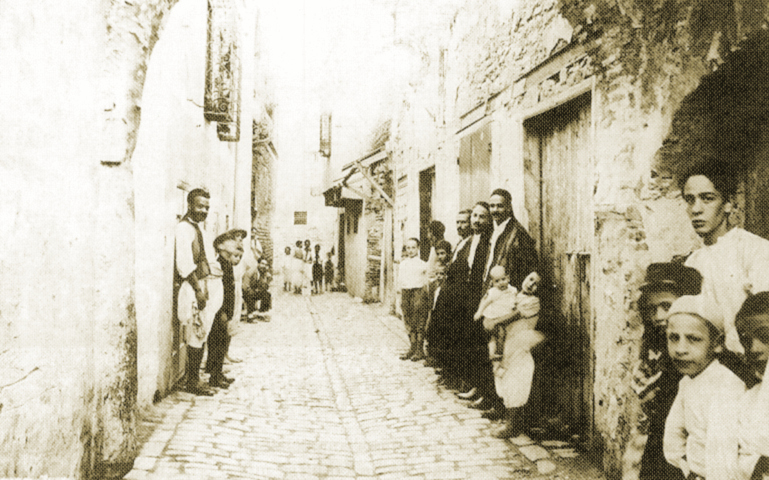There are perhaps 1,500 Jews in Tunisia in 2017. Within living memory, though, the country had a Jewish population of more than a hundred thousand.
From the 13th to 20th century, in the capital city, Tunis, the Jewish quarter was a poor neighborhood called the Hara. It was home to an intense, often insular Jewish community that spoke Judeo-Arabic.
This 1907 article suggests that the Hara celebrated every aspect of Purim in a big way: commemorating the story of Esther, widespread charity and hospitality, and, for some Jews, heavy drinking (of which the author clearly disapproves).
The writer’s description of Purim foods may be slightly “off,” but the article gives a vivid account of celebrations in what was once a vibrant Jewish neighborhood in North Africa.
PURIM IN TUNIS
by Mebasser
(Archives Israélites, March 21, 1907.
Translation from French ©2017 by Steven Capsuto.)
Passover is almost here, but perhaps it is still not too late to talk about Purim. In the Courrier de Tunisie, we find a piece by our contributor Mebasser, with picturesque new details about how Jews in Tunis celebrate the victory of Mordecai and Esther over Haman:
On the Saturday before Purim—known as Turnip Saturday or “Shabbat el Lefta,” which refers to a local legend—the young Jewish boys of the Hara are in the habit of celebrating Haman’s death. This mock ceremony is most unusual.
Early that morning, the boys gather in a very old house that lies in ruins at the heart of the Hara, in a place called the kharba.
There, as best they can, they use whatever they find at hand to fashion a small effigy—the kind that people try to knock over at a fair by throwing balls at it. This represents the famous Haman. They place him on a funeral litter and begin walking with it. They are followed by “Haman’s ten sons,” each with a funeral pall or wreath of similarly crude construction. This procession, numbering about a hundred urchins at the outset, travels through all the streets of the Jewish quarter, singing a popular chant: “Arour Amann oulila liltou ouradoi dfinlou,” which means “Curse Haman: this night is his last night and tomorrow we bury him.”
On each street, new contingents of boys swell the procession’s ranks, and at every door and window one sees Jewish women and especially Jewish girls, dressed as always in brilliant colors.
The walk lasts all of two to three hours. Then, towards evening, the boys take their Haman to the famous “kharba,” where they prepare the body. This is the simplest of procedures! Each armed with a stick, they rain so many blows on poor Haman (children are pitiless at that age) that the poor fellow is beaten to bits and the “ceremony” ends.
* * *
Residents of Tunis do things on a large scale. So besides the Purim “Mishloach Manot” gifts that people exchange—generally consisting of honeyed pastries called “debla” (a sort of dough, fried in oil and then soaked in honey…); and especially “makroudh” (flour kneaded in oil and stuffed with bad dates; this, too, is then fried in oil and soaked in honey), a thoroughly indigestible dish that our Tunisian Jews adore, which they eat in huge quantities on this day. Besides these presents, as I was saying, there are gifts of cash. This is the gift-giving holiday for Jews. Every family man must give each of his children their “Purim.”
The poor have their share as well.
Throngs of the destitute appear in Jewish neighborhoods on that day.
These unfortunates knock on every door and generally receive a warm welcome. Besides the silver coin that they are given without fail, they may be offered a drop of anisette or of the noxious boukha, which they accept without hesitation. After a few such handouts, the beggars become a bit tipsy.
Alongside the beggars, the streets are filled with people of every social station and age: men, women, boys and girls, holding out a handkerchief or a bag or else a poor box, often sealed. They go door to door and even approach passers-by, asking for some “flous” [money], usually for charitable projects but sometimes also for less urgent causes. They are, however, almost always well received.
Mebasser spends the rest of the article lamenting that too many Jews “follow too literally the outdated command to drink excessively on Purim, often with dire consequences.” The writer says the most visible manifestations of this on the streets of the Hara are some of the beggars who had made the rounds that morning. Around midday, we are told, they would carefully set aside half the money so their wives could prepare a holiday meal, and the rest of the alms would pay for bottles of boukha and for carriage rides:
These peregrinations make a fascinating spectacle: Packed like sardines into carriages from another era drawn by skeletal horses, they perch on the seat or atop their “Coach,” and I have even seen some riding the poor horses. They sing, whoop, gesticulate, and play music on bagpipes and “bendirs.” Sometimes, perilously (given the jolting of the carriage), they perform the… belly dance, which unfortunately is now so fashionable among nearly all the Jews of Tunis.
Thus provided with transportation, they ride up and down the streets of the Hara… jeering at anyone who stops to gape at them…
The article concludes by telling us that after this full day of commemoration, hospitality, charity, and family feasts, the night ends with a fair number of merry-makers “sleeping it off.”

